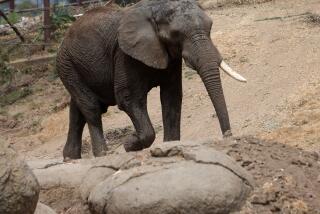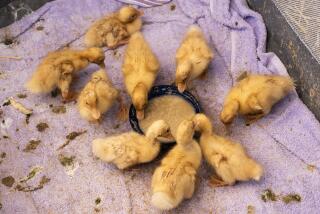Rehabilitation Center Cares for Sick, Abandoned Animals : Vet Devotes Life to Saving Those in Wild
- Share via
SAN JUAN ISLAND, Wash. — Veterinarian Jessica Porter doesn’t like to lose any of the animals that pass through the Wolf Hollow Wildlife Rehabilitation Centre, but the recent death of a red-footed booby bird was especially painful.
The bird, which Porter figures was from either Guam or Wake Island and accidentally caught a freighter to the West Coast, had spent a year being nursed back to health at the San Rafael Wildlife Center in Northern California.
But when it became clear that the sea bird was suffering neurological damage and couldn’t be returned to the wild, it was flown by commercial airline to Porter’s center for more specialized care.
“He was the nicest, sweetest guy,” Porter said of the bird that died in May. “We had him three days and he seemed to be doing fine. But then he convulsed and died a few minutes later. . . . It just crushed me.”
Porter, a slender, long-haired redhead, is a rarity herself. She is one of the few veterinarians in the country who devotes all her time to rehabilitating sick or abandoned animals for an eventual return to the wild.
Wolf Hollow is, in essence, a fledgling itself, having operated strictly as a wildlife center for only two years under Porter and co-founder Judy Carter. But in its second year, the center nursed approximately 300 animals back to health at the 40-acre facility and returned them to the wild.
Most of the creatures have been birds, but the center also has tended large numbers of harbor seal pups and fawns. In late June, the center was home for seven fawns, three premature harbor seals, a red-tailed hawk and several baby swallows and sparrows.
Most of the deer are ailing or stray fawns, but there is an alarming number of deformed fawns on this rural island about 75 miles northwest of Seattle.
“We are seeing fawns who are limbless, piebald and have hydrocephalus and other deformities,” Porter said. “Our research indicates the deformities are caused from inbreeding since this is a closed system (on the island). But we’re not ruling out the possibility of chemicals causing the problems.”
Porter said the cause of the seal deformities is obvious.
“The deformities among the seals are not surprising considering all of the chemicals that end up in the water,” said Porter, who spent nine weeks in Alaska caring for animals affected by the Exxon Valdez oil spill. “It’s enough to stop me from ever eating fish again.”
Porter believes there will be a growing number of wildlife veterinarians because of the never-ending encroachment of man into wildlife’s habitats.
“When I went to school (at Colorado State) there were no courses on wildlife,” she said. “But that is beginning to change. Right now, it’s a brand new science.
“For example, every time I write something about a discovery, such as our deformed deer, it is new research. We are pioneers. And the need to learn more about wildlife will grow as our cities continue to make islands out of our wildlife areas.
Porter said she doesn’t have to worry about losing her job in her lifetime because of the impact people have on wildlife.
“It’s tremendous,” she said. “The animals that are disappearing (becoming extinct) are the ones that just can’t stand being around humans. But most will be able to adapt.”
At present, Porter’s assistants include friends, relatives and two interns. She uses her home’s bathroom as an emergency care unit and only a small portion of the 40 acres the center leases is utilized, but growth is inevitable.
The land will eventually be purchased and all of it will be used; a hospital is planned, and an education program will be expanded.
While there are failures such as the death of the red-footed booby, the nonprofit center, which operated on about $30,000 in donations last year, has had its share of success.
More to Read
Sign up for Essential California
The most important California stories and recommendations in your inbox every morning.
You may occasionally receive promotional content from the Los Angeles Times.










